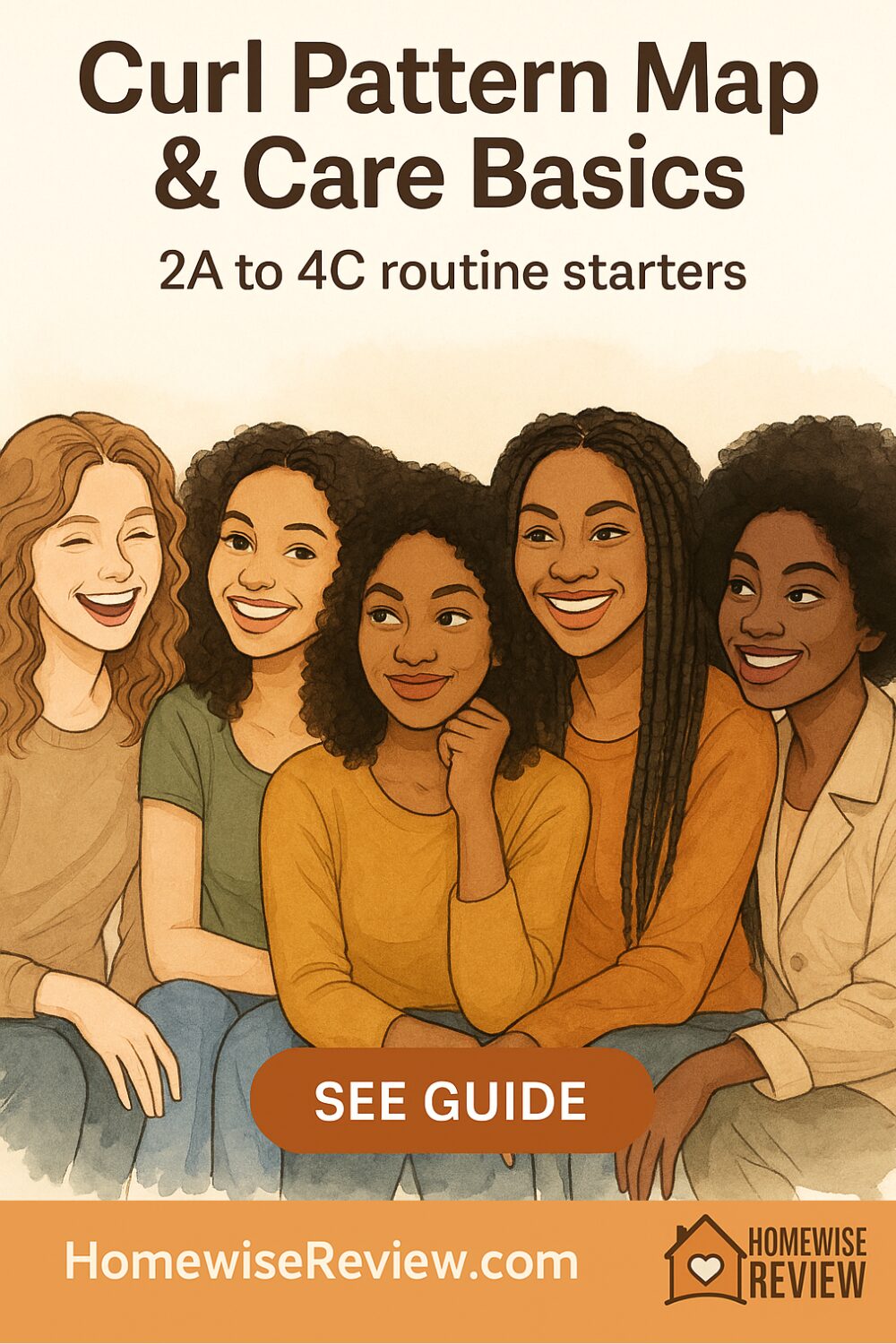
Learning your curl pattern is a shortcut to fewer bad hair days. Pattern is only one piece of the puzzle, but it helps you pick products and techniques that actually cooperate with your hair instead of fighting it. This guide maps the full range from soft waves to tight coils, then gives you simple routine starters you can try this week. We will also touch on porosity, density, and product pairing, because pattern alone never tells the whole story.
Think of this as a practical field guide. You will see how to spot your pattern family, the common pitfalls for each, and a low effort plan for wash day, styling, and refresh so your curls or coils look consistent without a drawer full of half-used products.
Quick pattern map
Pattern describes the shape hair springs into when it dries undisturbed. Start from clean, product-free hair for the most accurate read.
| Pattern | Typical look | Common challenges | Routine starter |
|---|---|---|---|
| 2A | Loose, beachy bend | Roots go flat, ends frizz | Light shampoo, weightless conditioner, foam or light mousse, air dry or low diffusing |
| 2B | Defined S-waves | Halo frizz, product overload | Lightweight leave-in, gel for hold, plop 10 minutes, diffuse on low |
| 2C | Deep waves, near curls | Humidity frizz, uneven clumps | Moisturizing conditioner, curl cream plus gel, diffuse to 80 percent dry |
| 3A | Big, loose curls | Stretching, cast that won’t break | Hydrating conditioner, cream-gel combo, scrunch out the crunch with a drop of oil |
| 3B | Springy curls, smaller diameter | Dry ends, shrinkage | Richer conditioner, cream plus medium hold gel, diffuse in sections |
| 3C | Tight corkscrews | Tangles, moisture loss | Slip-heavy conditioner, leave-in plus gel, sectioned application, hooded or mesh diffusing |
| 4A | Defined coils, S-shaped | Breakage at ends, moisture exit | Gentle shampoo, creamy conditioner, leave-in plus custard or gel, stretch sets |
| 4B | Z-pattern coils | Tangles, single strand knots | Co-wash between gentle shampoos, thick leave-in, cream styler, stretch without high heat |
| 4C | Tight coils with minimal visible definition until set | High shrinkage, dryness, fragile at seams | Sectioned wash, deep conditioning, leave-in plus butter or gel, twist or braid sets, careful tension stretch |
Before you start: three traits that matter more than pattern
- Porosity: How easily hair absorbs and loses water. High porosity loves leave-in plus a light oil seal. Low porosity prefers warm water, thinner products, and oil added after the hair is warm and damp.
- Density: How many strands per square inch. High density needs more product and sectioning. Low density needs lighter layers and less cast so the scalp does not show.
- Width: Fine strands get weighed down easily and need lighter products. Coarse strands can handle richer creams and butters without collapsing.
Routine starters by pattern family
Waves 2A to 2C
Wash day
- Cleanse with a lightweight shampoo that still removes oil. Condition mids to ends only. Detangle with fingers.
- For 2A, go even lighter on conditioner and rinse well. For 2C, leave a touch of conditioner in the ends.
Style
- 2A to 2B: apply a foam or light mousse root to tip, then a flexible gel on the ends.
- 2C: start with a pea of curl cream, then gel. Work in sections and scrunch.
Dry
- Plop for 10 minutes in a cotton tee. Diffuse on low until 80 percent dry or air dry if frizz is minimal.
Refresh
- Light mist of water plus a touch of mousse. Avoid cream on non-wash days to keep roots from collapsing.
Common fixes
- Halo frizz means you need a little more gel. Flat roots mean your conditioner is too heavy or you need a quick root clip while drying.
Curls 3A to 3C
Wash day
- Use a gentle shampoo weekly and a clarifier only when products pile up. Pick a conditioner with slip and leave a thin film in the ends.
Style
- Apply a leave-in on damp hair, then either cream plus gel or a single strong gel if humidity is high. Rake then scrunch.
- For 3C, section your head in 4 to 6 parts and apply product to each so clumps form evenly.
Dry
- Diffuse on low to medium with head tilted to protect pattern. If frizz creeps in, stop, add a touch more gel, and continue.
Refresh
- Water plus gel in a spray bottle. Scrunch with a microfiber towel. Break cast with a drop of lightweight oil.
Common fixes
- Hard, crunchy ends need more water in your application. Frizz at the crown needs more gel and less touching while drying.
Coils 4A to 4C
Wash day
- Detangle in sections on soaking wet hair. Use a gentle shampoo on the scalp. Follow with a slip-rich conditioner and work from ends up.
- Deep condition weekly for 20 to 30 minutes. If hair feels mushy when wet, swap the deep conditioner for a light protein that week.
Style
- Apply leave-in on damp hair, then a cream for slip. Choose a custard or gel for hold depending on humidity.
- Set with twists, braids, flexi-rods, or perm rods. For stretch, banding or African threading works without high heat.
Dry
- Sit under a hooded dryer or air dry fully before taking sets down. Coat fingertips with a drop of oil when separating.
Refresh
- Re-twist at night on a light mist of water plus leave-in. For wash and go weeks, add gel to frizz zones and let them air set.
Common fixes
- Flakes after gel mean incompatible products. Pair cream and gel from the same brand family or check our mixing guidance in Product Layering to Avoid Flakes on 4C Hair.
- Mid-shaft breakage at the line of demarcation means you need a lighter hand when detangling and a scheduled protein every 2 to 4 weeks.
Product pairing rules that keep definition
- Apply products on damp, not dripping hair so water is not diluting your hold.
- For humidity, lean on gels with film formers and seal ends with a tiny amount of serum.
- If creams cause collapse, switch to a leave-in plus gel only.
- If gels feel too hard, add a small amount of cream under gel or scrunch out the crunch with a drop of oil.
- Clarify or chelate on a schedule so buildup does not sabotage results.
Troubleshooting quick hits
- Frizz everywhere: Add water during application, increase gel amount, stop touching while drying.
- Flat roots: Reduce conditioner near the scalp, switch to lighter leave-in, clip roots while drying, diffuse upside down briefly.
- White flakes: Your cream and gel are fighting. Change one product or apply gel directly over soaking wet hair.
- Dry, crunchy ends: Trim if needed, then add a weekly moisture mask and seal with a tiny drop of oil only on the last two inches.
- Shrinkage shock: Build in stretch with a roller set, banding, or a low heat tension blowout before styling.
Final Thoughts
Pattern is a helpful compass, not a full GPS. Start with the routine for your family, then fine tune by porosity, density, and daily life. Keep wash day simple, use enough water during application, and pick either cream-plus-gel or gel-only based on how much hold you need. With a steady routine and light tweaks, you will see fewer surprise frizz days and more predictable curl or coil definition.
See Also
If your base routine needs a refresh, Find the Right Shampoo for Your Hair and Scalp walks through cleanser strength by scalp type so you stop over or under washing. For tight textures, Wash Day Routine for 4C Hair Step by Step shows sectioning and detangling that protect the line of demarcation while you build definition.
When you want to stretch without damage, the Stretch and Style Hub: Heat, Sets, and Protection breaks down roller sets, banding, wraps, and cautious blowouts. Fighting flakes after gel combos or humid weather sets? Product Layering to Avoid Flakes on 4C Hair explains which mixes play nicely so your definition holds. If you prefer low heat styling with long lasting shape, Best Hair Rollers & Hot Rollers for Soft Waves is a good place to start for gentle stretch and volume.
FAQs
How do I find my real pattern if my hair always looks the same after styling
Cleanse and condition, skip heavy leave-ins, then apply only water and a tiny amount of gel. Air dry without touching. The shape you see is your real pattern baseline.
What matters more than pattern for product choice
Porosity and strand width. High porosity likes leave-in plus a light seal. Fine strands prefer thinner products and gel over cream.
How do I reduce frizz without losing volume
Use a lighter cream or go gel-only, apply on damp hair, and diffuse in short bursts with root clips. Break the cast only when fully dry.
Can I air dry with high density hair
Yes, but expect a longer dry time. Section for product application and consider a hooded dryer or mesh diffuser cap to cut time without blasting heat.
How often should I clarify
Every 2 to 4 weeks if you layer creams and gels, or monthly if your routine is light. If you live with hard water, add a monthly chelating cleanse.
Affiliate Disclosure
If you purchase through links on our site, we may earn a small commission at no extra cost to you.




